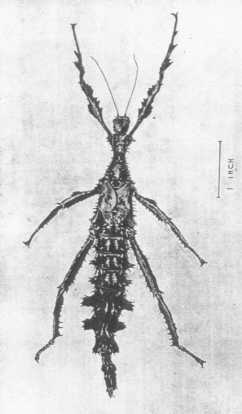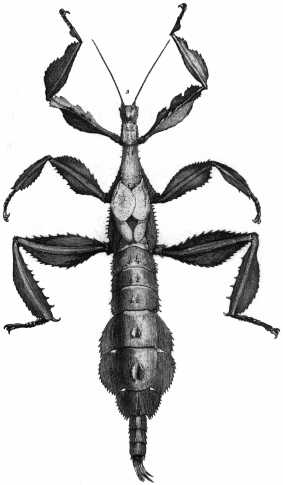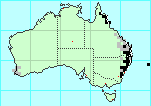
Key 1994

Slater, 1997

Rentz 1996

Rentz 1996

Rentz 1996

Key 1994

Froggatt, 1922

Macleay 1826
 Key 1994 |
 Slater, 1997 |
 Rentz 1996 |
 Rentz 1996 |
 Rentz 1996 |
 Key 1994 |
 Froggatt, 1922 |
 Macleay 1826 |

male volant and macropterous, female brachypterous (from Balderson et al, 1998)
The male has large mottled wings, a smaller tuft of head spines, and 3 occelli. Males fly readily when disturbed or when in search of females.
They are very active in the early instar stages and seem to continually seek to travel upward, seemingly with an effort to attain the highest branches of the trees they occupy. (from Rentz 1996.)
The female is heavy-bodied, brachypterous and has numerous spines and integumental expansions on the body and legs, including a tuft of spines on the conical occiput of the hypognathous head.
The 1st instar has an aposematic pattern of black, with orange head and whitish collar; in its colouring, posture and movements it appears to mimic ants of the genus Leptomyrmex. (from Key 1994.)
Female. Length from front of head to tip of body 5 inches; male unknown. Colour deep green, lightest on the wing pads; abdomen and legs mottled with dull white and greyish spots. Fine spines on head, thorax, and abdomen reddish-brown. It differs from Extatosoma tiaratum in being much more slender in form, and in having the more slender legs with very narrow arcuate flanges or ridges on the femora and tibia, with small lateral flanges on the sides of the first four abdominal segments, and those on the following very much reduced in size; the whole surface is covered with stout spines, thickest on the under surface. The sides and crown of the head thickly covered with sharp pointed spines, with two double spines on the summit. The prothorax covered with similar spines with two double-spined ones on the hind margin; the mesothorax bearing spines on the sides, with three pairs on the dorsal surface, the first pair conical, blunt at apex, with a group of two thickened spines und two single ones in front of the base of the insertion of the tegmina, the metathorax with four parallel rows of smaller spines on the dorsal surface. The legs with the dorsal and lateral edges toothed with short mottled thorn-like spines, the coxae usually bearing shorter stout conical spines, with an odd double spine here and there.
The first three abdominal segments rounded, with a pair of double finger-like spines in the centre of the back and simple spines on either side; below there, standing out is a horny, arcuate, spined, flattened flange. The fifth and sixth segments have a pair of serrate, parallel, erect flanges in the centre of the back and two stout spines; on either side is a large flattened serrate flange in a line with those of the first three segments, about a third larger, and spined in the same manner. The 7th abdominal segment is small, with similar but smaller spines, and the side flanges are turned downwards. The 8th and 9th are small, projecting above the genitalia with similar small spines, and the hind margin of the anal one is fringed with spines. The ventral surface and sides of the abdominal segments are lightly covered with slender reddish-brown spines. (from Froggatt, 1922)
Male: wings are of a blackish colour, with interrupted spotted whitish bands, while the costal area is green with transverse undulated blackish bands; the tegmina are also green, and very much ridged; the mesothorax short, narrow, but widening behind, with two spines situated before; the abdomen is narrow, of a brownish green, with the tip turned up; the legs are very much dilated throughout, green with blackish transverse narrow bands; the fore thighs are trigonal.
Female: Its general colour is brownish green, but it is much thicker in proportion than the last; the abdomen has rows of laminæ on the upper surface, which are dentated and of a dark brownish black. It is also armed at the tip with a strong, sharp, curved, black claw; the prothorax as well as mesothorax are spined, the latter, which is somewhat triangular, only on the fore part ; the tegmina and wings are rudimental; the legs are very much dilated, the thigh and shank trigonal, but the margins of the dilatation dentated; the first joint of the fore feet is dilated, and erect. (from Gray, 1833)
Female: Corpore fere quinque unciarum longo cuneiformi viridi, capite tiarâ acuminatâ spinulosâ coronato, thorace antice angusto subdepresso spinuloso postice dilatato convexiori marginibus lateralibus denticulatis, abdomine antice cylindrico medio valde dilatato margine dentato et in processum segmentorum trium linearem desinente segmentis supra binis laminis dentatis in medio armatis, elytris viridibus subovatis minutis alarum rudimentis brevioribus; pedibus viridibus coxis triquetris, anticis angulo interiori tridentato, superiori denticulato processu ad apicem cristato, inferiori dilatato rotundato, quatuor posticis dilatatis ovatis margine denticulatis, femoribus anticis extus dilatatis rotundatis apicem versus subemarginatis, quatuor posticis triquetris angulis dentatis exteriori valde dilatato. (from Macleay 1826.)
Length: Female 5 inches (from Musgrave 1922.)
Coloring:
The species is highly variable in colouring,
being oberved as brownish, dun, reddish, greenish.
 Brock 2002 |
 Key 1991 |
Note typical vegetation, e.g. tropical rainforest, temperate rainforest, grasslands, alpine, etc.
PSG notes indicate the following foodplants have been used successfully in captivity: Bramble, Eucalyptus, Hawthorn, Oak, Pyracantha, Raspberry, Rose.
For a stick insect with body length 127mm, to keep 2 adult females,
you need a cage at least 600mm high, 300mm deep and 300mm wide.
 Range:
Range: Extralimital Distribution: New Guinea.
It is not known if this species is endangered in the wild, as there is insufficient sighting history.
|
Copyright © 2000-2003
Peter Miller
This page was last changed 20-Sep-2006. |

|

|